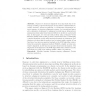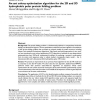148 search results - page 17 / 30 » The evolutionary capacity of protein structures |
RECOMB
2007
Springer
14 years 7 months ago
2007
Springer
Abstract. Sequence to structure alignment is an important step in homology modeling of protein structures. Incorporation of features like secondary structure, solvent accessibility...
BMCBI
2006
13 years 7 months ago
2006
Background: Cellular metabolism can be characterized by networks of enzymatic reactions and transport processes capable of supporting cellular life. Our aim is to find evolutionar...
BMCBI
2008
13 years 7 months ago
2008
Background: As a rule, peptides are more flexible and unstructured than proteins with their substantial stabilizing hydrophobic cores. Nevertheless, a few stably folding peptides ...
BMCBI
2005
13 years 7 months ago
2005
Background: The protein folding problem is a fundamental problems in computational molecular biology and biochemical physics. Various optimisation methods have been applied to for...
BMCBI
2006
13 years 7 months ago
2006
Background: The problem of inferring the evolutionary history and constructing the phylogenetic tree with high performance has become one of the major problems in computational bi...


